Abstract
Improvement of the performance of renewable electronic devices is a crucial point for the consolidation of this emerging technology. Herein, we develop a supercapacitor based on cellulose, carbon nanotubes, and ionic liquids. A conductive paper prepared by simple acid hydrolysis of cellulose and carboxylated carbon nanotubes was used as an electrode. A cellulose sponge impregnated with 1-n-butyl-3-methylimidazolium bis(trifluoromethane sulfonyl)imide was used as a separator/electrolyte. Electrochemical tests were performed in a two-electrode cell that presented a specific capacitance of 34.37 F/g when considered the active mass and 97.9% of capacitance retention after 5000 charge/discharge cycles.






Similar content being viewed by others
References
B. Yao, J. Zhang, T. Kou, Y. Song, T. Liu, and Y. Li: Paper-based electrodes for flexible energy storage devices. Adv. Sci. 4, 1028–1036 (2017).
J.-W. Han, B. Kim, J. Li, and M. Meyyappan: A carbon nanotube based humidity sensor on cellulose paper. J. Phys. Chem. C 116, 22094–22097 (2012).
B. Noremberg, S.R. Silva, M.O. Paniz, G.J. Alano, H.M.R.F. Gonçalves, S. Wolke, I.J. Labidi, A. Valentini, and N.L.V. Carreno: From banana stem to conductive paper: A capacitive electrode and gas sensor. Sens. Actuators B 240, 459–467 (2017).
K. Devarayan, D. Lei, H. Kim, and B. Kim: Flexible transparent electrode based on PANi nanowire/nylon nanofiber reinforced cellulose acetate thin film as supercapacitor. Chem. Eng. J. 273, 603–609 (2015).
S. Liu, T. Yu, Y. Wu, W. Li, and B. Li: Evolution of cellulose into flexible conductive green electronics: a smart strategy to fabricate sustainable electrodes for supercapacitors. RSC Adv. 4, 34134–34143 (2014).
B. Anothumakkool, R. Soni, S.N. Bhange, and S. Kurungot: Novel scalable synthesis of highly conducting and robust PEDOT paper for high performance flexible solid-supercapacitor. Energy Environ. Sci. 8, 1339–1347 (2015).
M. Gelesky, C. Scheeren, L. Foppa, F. Pavan, S. Dias, and J. Dupont: Metal nanoparticle/ionic liquid/cellulose: new catalytically active membrane materials for hydrogenation reactions. Biomacromolecules 5050, 1888–1893 (2009).
V. Martins, L. R., and Torresi M. Ionic liquids in electrochemical energy storage. Curr. Opin. Electrochem. 9, 26–32 (2018).
F.M. Pelissari, P.J.D.A. Sobral, and F.C. Menegalli: Isolation and characterization of cellulose nanofibers from banana peels. Cellulose 21, 417–432 (2014).
C. Cassol, G. Ebeling, and B. Ferrera: A simple and practical method for the preparation and purity determination of halide-free imidazolium ionic liquids. Adv. Synth. Catal. 348, 243–248 (2006).
H. Ji, X. Zhao, Z. Qiao, J. Jung, Y. Zhu, Y. Lu, L. Zhang, A. MacDonald, and R. Ruof: Capacitance of carbon-based electrical double-layer capacitors. Nat. Commun. 5, 1–7 (2014).
M.F. Rosa, X. Zhao, Z. Qiao, J. Jung, Y. Zhu, Y. Lu, L. Zhang, A. MacDonald, and R. Ruof: Cellulose nanowhiskers from coconut husk fibers: effect of preparation conditions on their thermal and morphological behavior. Carbohydr. Polym. 81, 83–92 (2010).
R. Silva, B. Noremberg, N. Marins, J. Alano, L. Santana and A. Valentini, and N. Carreño: Flexible cellulose-carbon nanotube paper substrate decorated with PZT: sensor properties. MRS Adv. 3(1–2), 31–36 (2018).
S. Li, D. Huang, J. Yang, and B. Zhang: Freestanding bacterial cellulose–polypyrrole nanofibres paper electrodes for advanced energy storage devices. Nano Energy 9, 309–317 (2014).
J.B. Jorcin, M.E. Orazem, N. Pébère, and B. Tribollet: CPE analysis by local electrochemical impedance spectroscopy. Electrochim. Acta 51, 1473–1479 (2006).
R. Thangavel, A. Kannan, R. Ponraj, V. Thangavel, D. Kim, and Y. Lee: High-energy green supercapacitor driven by ionic liquid electrolytes as an ultra-high stable next-generation energy storage device. J. Power Sources 383, 102–109 (2018).
L. Hu, N. Liu, M. Eskilsson, G. Zheng, J. McDonough, L. Wagberg, and Y. Cui: Silicon-conductive nanopaper for Li-ion batteries. Nano Energy 2, 138–145 (2013).
Acknowledgment
This study was financed in part by the Coordenaçâo de Aperfeiçoamento de Pessoal de Nivel Superior-Brasil (CAPES)-Finance Code 001. The authors would like to acknowledge Fapergs/PqG 2017 17/2551-0001157-0, CAPES PDSE/88881.187730/2018-01, and Celulose Riograndense-Brazil.
Author information
Authors and Affiliations
Corresponding author
Rights and permissions
About this article
Cite this article
Noremberg, B.S., Silva, R.M., Paniz, O.G. et al. Renewable supercapacitors based on cellulose/carbon nanotubes/[Bmim] [NTf2] ionic liquid. MRS Communications 9, 726–729 (2019). https://doi.org/10.1557/mrc.2019.34
Received:
Accepted:
Published:
Issue Date:
DOI: https://doi.org/10.1557/mrc.2019.34




